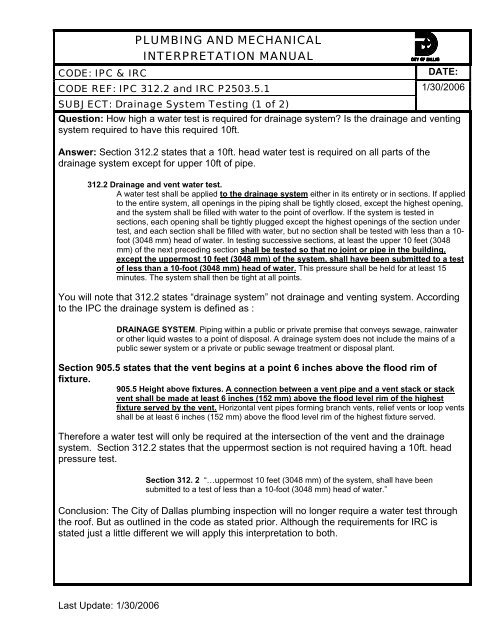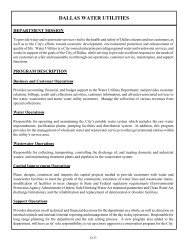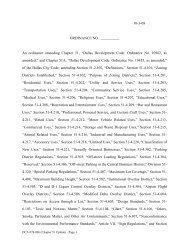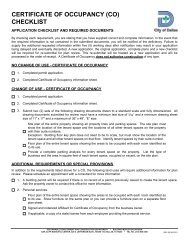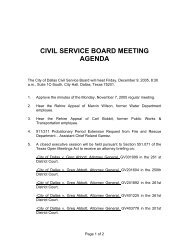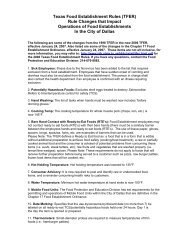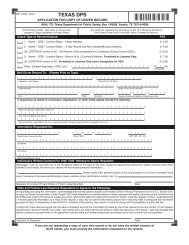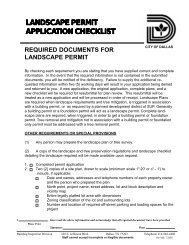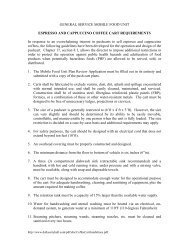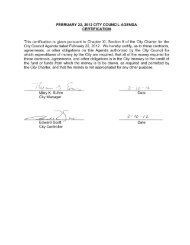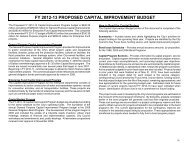PLUMBING AND MECHANICAL - City of Dallas
PLUMBING AND MECHANICAL - City of Dallas
PLUMBING AND MECHANICAL - City of Dallas
Create successful ePaper yourself
Turn your PDF publications into a flip-book with our unique Google optimized e-Paper software.
CODE: IPC & IRC<br />
<strong>PLUMBING</strong> <strong>AND</strong> <strong>MECHANICAL</strong><br />
INTERPRETATION MANUAL<br />
CODE REF: IPC 312.2 and IRC P2503.5.1<br />
SUBJECT: Drainage System Testing (1 <strong>of</strong> 2)<br />
DATE:<br />
1/30/2006<br />
Question: How high a water test is required for drainage system Is the drainage and venting<br />
system required to have this required 10ft.<br />
Answer: Section 312.2 states that a 10ft. head water test is required on all parts <strong>of</strong> the<br />
drainage system except for upper 10ft <strong>of</strong> pipe.<br />
312.2 Drainage and vent water test.<br />
A water test shall be applied to the drainage system either in its entirety or in sections. If applied<br />
to the entire system, all openings in the piping shall be tightly closed, except the highest opening,<br />
and the system shall be filled with water to the point <strong>of</strong> overflow. If the system is tested in<br />
sections, each opening shall be tightly plugged except the highest openings <strong>of</strong> the section under<br />
test, and each section shall be filled with water, but no section shall be tested with less than a 10-<br />
foot (3048 mm) head <strong>of</strong> water. In testing successive sections, at least the upper 10 feet (3048<br />
mm) <strong>of</strong> the next preceding section shall be tested so that no joint or pipe in the building,<br />
except the uppermost 10 feet (3048 mm) <strong>of</strong> the system, shall have been submitted to a test<br />
<strong>of</strong> less than a 10-foot (3048 mm) head <strong>of</strong> water. This pressure shall be held for at least 15<br />
minutes. The system shall then be tight at all points.<br />
You will note that 312.2 states “drainage system” not drainage and venting system. According<br />
to the IPC the drainage system is defined as :<br />
DRAINAGE SYSTEM. Piping within a public or private premise that conveys sewage, rainwater<br />
or other liquid wastes to a point <strong>of</strong> disposal. A drainage system does not include the mains <strong>of</strong> a<br />
public sewer system or a private or public sewage treatment or disposal plant.<br />
Section 905.5 states that the vent begins at a point 6 inches above the flood rim <strong>of</strong><br />
fixture.<br />
905.5 Height above fixtures. A connection between a vent pipe and a vent stack or stack<br />
vent shall be made at least 6 inches (152 mm) above the flood level rim <strong>of</strong> the highest<br />
fixture served by the vent. Horizontal vent pipes forming branch vents, relief vents or loop vents<br />
shall be at least 6 inches (152 mm) above the flood level rim <strong>of</strong> the highest fixture served.<br />
Therefore a water test will only be required at the intersection <strong>of</strong> the vent and the drainage<br />
system. Section 312.2 states that the uppermost section is not required having a 10ft. head<br />
pressure test.<br />
Section 312. 2 “…uppermost 10 feet (3048 mm) <strong>of</strong> the system, shall have been<br />
submitted to a test <strong>of</strong> less than a 10-foot (3048 mm) head <strong>of</strong> water.”<br />
Conclusion: The <strong>City</strong> <strong>of</strong> <strong>Dallas</strong> plumbing inspection will no longer require a water test through<br />
the ro<strong>of</strong>. But as outlined in the code as stated prior. Although the requirements for IRC is<br />
stated just a little different we will apply this interpretation to both.<br />
Last Update: 1/30/2006
CODE: IPC & IRC<br />
<strong>PLUMBING</strong> <strong>AND</strong> <strong>MECHANICAL</strong><br />
INTERPRETATION MANUAL<br />
CODE REF: IPC 312.2 and IRC P2503.5.1<br />
SUBJECT: Drainage System Testing (2 <strong>of</strong> 2)<br />
DATE:<br />
1/30/2006<br />
Highest Level <strong>of</strong> Water<br />
Test Required<br />
6” above flood rim <strong>of</strong><br />
fixture<br />
“..but no section shall be tested<br />
with less than a 10-foot (3048 mm)<br />
head <strong>of</strong> water.”<br />
“…except the uppermost 10 feet<br />
(3048 mm) <strong>of</strong> the system, shall<br />
have been submitted to a test <strong>of</strong><br />
less than a 10-foot (3048 mm)<br />
head <strong>of</strong> water.”<br />
312.2 Drainage and vent water test.<br />
A water test shall be applied to the drainage<br />
system either in its entirety or in sections. If<br />
applied to the entire system, all openings in the<br />
piping shall be tightly closed, except the highest<br />
opening, and the system shall be filled with<br />
water to the point <strong>of</strong> overflow. If the system is<br />
tested in sections, each opening shall be tightly<br />
plugged except the highest openings <strong>of</strong> the<br />
section under test, and each section shall be<br />
filled with water, but no section shall be tested<br />
with less than a 10-foot (3048 mm) head <strong>of</strong><br />
water. In testing successive sections, at least<br />
the upper 10 feet (3048 mm) <strong>of</strong> the next<br />
preceding section shall be tested so that no<br />
joint or pipe in the building, except the<br />
uppermost 10 feet (3048 mm) <strong>of</strong> the system,<br />
shall have been submitted to a test <strong>of</strong> less than<br />
a 10-foot (3048 mm) head <strong>of</strong> water. This<br />
pressure shall be held for at least 15 minutes.<br />
The system shall then be tight at all points.<br />
SIGNATURE: Lonnie Erwin,<br />
Chief Plumbing and Mechanical Inspector<br />
<strong>City</strong> <strong>of</strong> <strong>Dallas</strong><br />
Last Update: 1/30/2006


